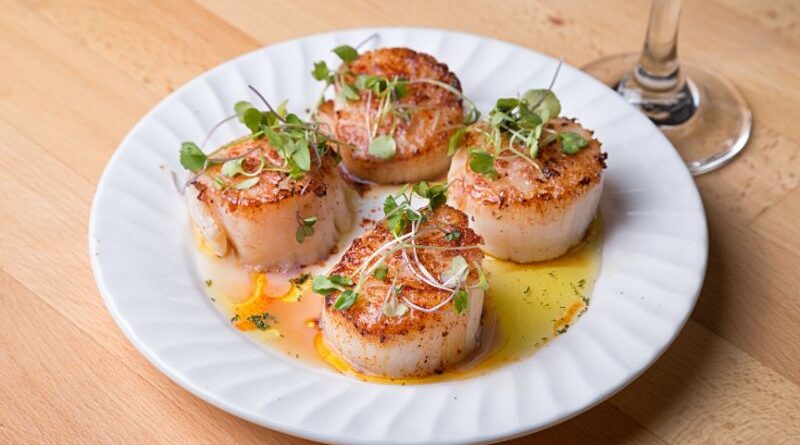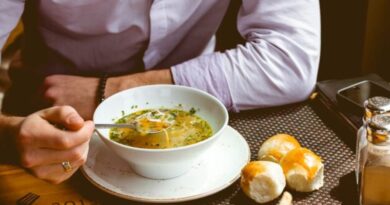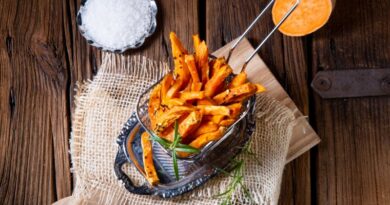The article contains an overview of What Do Scallops Look Like and all details about scallops. If you are thinking of cooking seafood today, you can try scallops recipes. Indeed It will be a delicious seafood treat for you. Moreover, scallops are the most nutritious source of protein and are generally safe to eat. In addition, it promotes heart and brain health. So if you aren’t allergic to seafood or are being advised not to consume seafood during pregnancy, you can go for scallops. You can add them to your meals for a healthy and delicious addition. Let’s check out the article providing you a brief overview of what do scallops look like and other details about scallops:
What are Scallops?
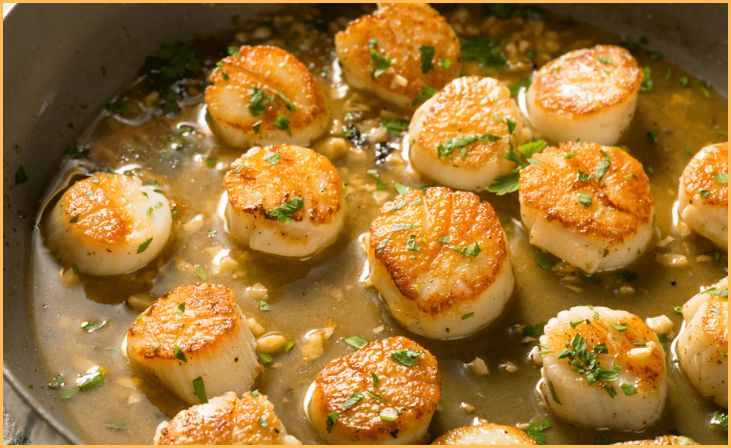
Scallops are one of the most expensive seafood, rich in protein. So If you are asking what scallops are, they are bivalve mollusks that live in shells in saltwater. Scallops have a soft, velvety texture with a delicate taste. Both bay and ocean waters are home to scallops. They have a texture somewhat similar to white fish and a sweet flavor appropriate for many different dishes. Unfortunately, scallops may cause allergic reactions in some people, so anyone with a previous allergy to mollusks or shellfish may find it beneficial to avoid them.
Read also: What Is The Internal Temp Of Steak On Grill?
What do Scallops Look Like?
The unique appearance of scallops distinguishes them in the marine world. Their shells, often associated with coastal aesthetics, showcase a fanned-out form that sets them apart. However, what truly surprises many is their remarkable ability: unlike other bivalves, scallops exhibit a fascinating trait – they swim. With nimble movements, they maneuver across the ocean floor by rhythmically clapping their shells together, showcasing an agility that’s distinct within their species.
But perhaps the most intriguing aspect lies in their unexpected feature: scallops possess vivid blue eyes. Yes, it’s true – within the entrance of their shells, reside 50 to 100 minuscule, bead-like blue eyes. These specialized organs enable scallops to sense their environment, perceiving changes in light, darkness, and motion. Remarkably, they even employ retinas to focus on light, akin to the mechanism employed by humans.
This surprising revelation of scallops possessing these intricate sensory abilities adds to their mystique. Their visual capabilities and unique locomotion elevate these shellfish beyond mere culinary ingredients, unveiling a fascinating facet of marine life that captivates and intrigues those who delve into their world.
How to Cook Scallops?

A dish of scallops are delcious to eat, and not so difficult to cook as it appears. You can cook restaurant-style scallops with a pan sauce in less than 15 minutes. Serve these scallops with salad, white bread or simply with red wine. And your quick and delicious dinner is ready in a few minutes.
Here are a few steps that will cook your scallops quickly and inelegant way:
- M ake sure to buy dry scallops, as wet scallops contain chemical additives. However, dry ones also contain little mositure. You need to make them dry too using kitchen towels.
- Then, check to see if the scallop’s little side muscles have been removed – if not, remove them with your fingers.
- Sprinkle some salt and pepper on scallops or use any seasonings you like.
- Add a bit of olive oil in skillet and heat it on medium high, until it is very hot and shimmering.
- Place your seasoned scallops in it using tongs.
- Cook it for 3 to 4 minutes or until the colors turn into golden brown.
- Now baste the scallops using butter and aromatics of your choice. You can try chilli pepper or herbs.
- Use the large spoon to baste the scallops nicely.
- Remove the scallops from the heat when the flesh near top and bottom edges of the scallops starts looking opaque.
- Place the scallops on the serving plate.
- Add a dash of liquid to the butter in the pan, such as lemon juice, white wine, chicken or vegetable stock, dry vermouth, or orange juice, etc., according to the flavor you believe works best with your seasoning and basting ingredients.
- Stir the sauce over medium heat, then remove from heat and remove the aromatics.
- Finish with a little more cold butter, and fresh herbs if you like.
- The buttery scallop dish is ready when you pour the sauce around the scallops.
What do Scallops Taste Like?
It has always been difficult to describe the flavour of any type of fish. Regardless of how difficult it is, I will describe what the flavor is like to me so that you have a general notion of what to expect.
Their flavor is more like that of most seafood, which is fresh and has a distinct salty fragrance. The main difference is that they have the characteristic flavor of a fatty and delicious chunk of yam.
Scallops have a little chewy and soft feel. Scallops, in general, have a sweet flavor, which is why most people refer to them as “the sea candy.”
How to Buy Scallops?
Scallops, like any other seafood, should be purchased using your sight and nose. Fresh scallops should be juicy but not milky in appearance. Reject any with a fluffy white surface (an indication of freezer burn) or dry and darkened edges (a sign of age). Before purchasing scallops, always request that they be smelled. They should smell saline and seaweedy, but not unpleasant, harsh, or iodine-like. If the scallops have no odor and are a uniform bright white hue, they’ve most likely been soaked in stp.
Read also: Can You Freeze Mashed Potato For Later Use?
How to Store Scallops?
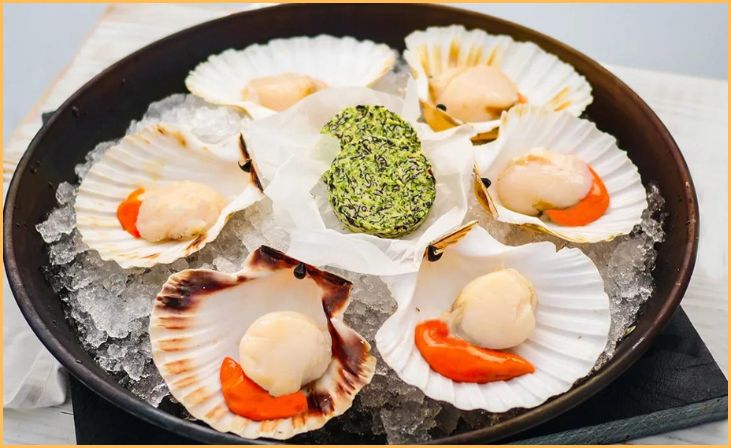
Our fresh Jumbo Scallops are a delectable treat that’s worth savoring in abundance! If you find yourself with more than you can enjoy within the initial two days, freezing them is an excellent option to preserve their quality. To ensure optimal freezing, wrap the scallops in a moisture-resistant covering or place them in a freezer bag.
For added protection, utilizing a vacuum sealer or high-quality moisture-resistant wrap is recommended. Double-wrap the scallops for extra security. Don’t forget to label and date the freezer wrap before placing the scallops in a freezer set to 0 degrees F or below. With proper storage, these delectable scallops can maintain their quality for up to two months, allowing you to relish their freshness whenever you desire.
Conclusion
Scallops, with their distinctive appearance and unique flavor, offer a delightful addition to culinary creations. Recognizable for their plump, tender texture and subtly sweet taste, these shellfish are versatile and can be seared, grilled, or used in various dishes. Understanding their appearance, flavor, texture, and proper storage ensures an enjoyable and delectable dining experience.
FAQs
Scallops appear as creamy-white, circular, or oval-shaped shellfish with a firm, plump texture and a slight translucency. They typically have a convex and a flat side.
Scallops offer a delicate, mildly sweet taste with a hint of brininess from the sea. Their flavor is subtle, allowing them to complement various seasonings and sauces.
Scallops have a tender, moist, and slightly chewy texture. When cooked properly, they should be tender but not rubbery, offering a pleasant bite.
Store fresh scallops in the coldest part of the refrigerator, ideally wrapped in a paper towel and placed in an airtight container. Consume them within a day or two for the best quality.
Yes, scallops can be frozen for future use. Ensure they’re properly sealed to prevent freezer burn. When thawed, use them promptly for optimal taste and texture.

